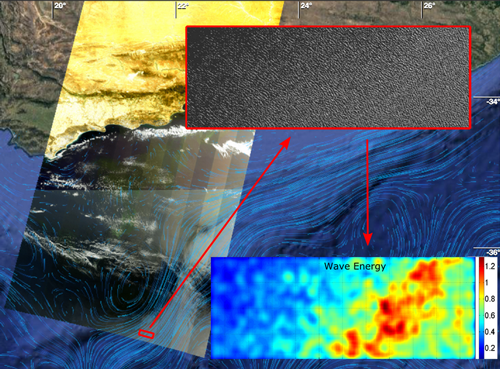Source: Journal of Geophysical Research: Oceans
Children use glitter in arts and crafts. Manufacturers put glitter in cosmetics. Scientists use glitter to learn more about the ocean.
Wait…what?
It turns out that the glitter of sunlight reflecting off the ocean’s surface can provide a wealth of information to marine scientists. Various sensors installed on satellites are specially designed to detect these reflections, collecting detailed information about the direction, height, and movement of surface-level waves.
Caused by wind blowing across the surface of the ocean, wave patterns are complex and highly variable. Being able to accurately predict their movements can greatly benefit mariners, port and rig builders, coastal farmers, and more, but the measurements provided by buoys and ships have many limitations.
Last year, a team of European scientists developed a method to observe patterns in waves at the surface of the ocean using Sun glitter imagery collected via satellite. Their method involves examining data from a multispectral camera aboard Europe’s Sentinel-2 spacecraft, which captures Sun glitter data from across the electromagnetic spectrum, including from visible and infrared light.

Building on this technique, Kudryavtsev et al. used Sun glitter imagery from Sentinel-2 to map a fuller range of motion at the ocean’s surface. To do this, they suggested a method to convert Sun glitter brightness modulations to ocean wave heights. Moreover, using a time delay between acquisitions in two different spectral channels, they suggested a method to measure velocities of waves and the surface current. With these data, they sought to better evaluate and forecast wave behavior.
The authors tested their method on the Agulhas Current, a historically treacherous current around the southernmost coast of Africa. Using satellite data collected in January 2016, they traced the behavior of ocean waves and their interactions with currents.
They found that ocean surface currents modify dominant surface waves, which are the tallest surface-level waves in a given area, driven by local wind and large-scale swells. They also showed how wave packets (clusters of waves that move together as one) can be deflected and trapped by ocean surface currents, creating surface-level waves that are much higher than normal.
As satellite technology develops and higher-resolution Sun glitter imagery becomes available, scientists hope to be able to study waves and currents at the surface of the ocean in even greater detail. This detail would further improve scientists’ ability to derive more direct ocean surface current measurements from satellite data and to provide critical wave forecasts. (Journal of Geophysical Research: Oceans, https://doi.org/10.1002/2016JC012426, 2017)
—Sarah Witman, Freelance Writer
Citation:
Witman, S. (2017), Sun glitter provides a detailed map of ocean waves, Eos, 98, https://doi.org/10.1029/2017EO069959. Published on 20 March 2017.
Text © 2017. The authors. CC BY-NC-ND 3.0
Except where otherwise noted, images are subject to copyright. Any reuse without express permission from the copyright owner is prohibited.

